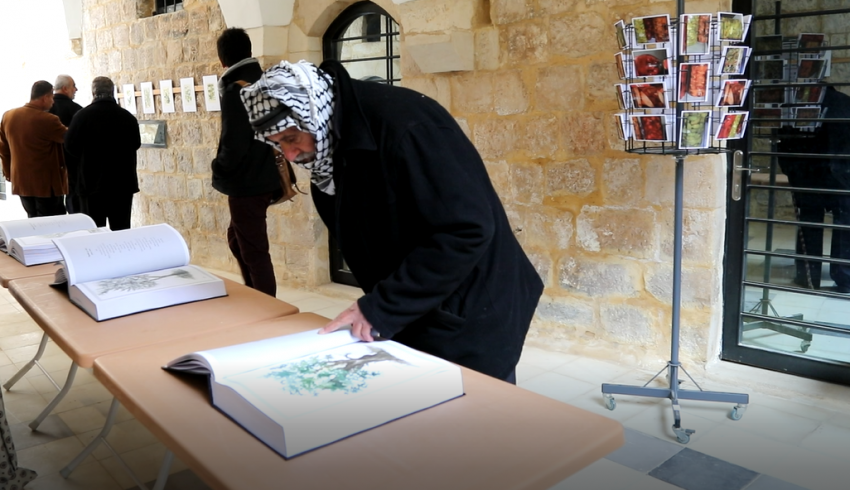
In partnership with the Asira al-Shamaliya Municipality and Club, the Public Programme (PP) of the A. M. Qattan Foundation (AMQF) and RIWAQ inaugurated an art exhibition titled Creative Margins. The exhibition was curated by Nour Rawajbeh and Majadah al-Shouli.
The exhibition marked the starting point of the artist residency programme, Creative Margins. The programme mainly aims at decentralising cultural production from urban centres being at its core, to the Palestinian marginalised communities. It strives for cultural and intellectual investment in the margins in order to propagate the seeds of cultural change.
Abed Al-Rahman Shabaneh, PP Assistant Curator, stated: “This artist residency has promoted and transferred art production to rural areas. This experience has uncovered many talents in the village of Asira al-Shamaliya. It has been a model for cultural production across villages, beyond urban centres.”
The exhibition was an outcome of a research project conducted by both artists in the surrounding areas of their village of Asira al-Shamaliya near Nablus. The artists wandered through the village’s agricultural and natural scenery. Majadah al-Shouli collected around 91 species of plants and looked for their scientific and local names. In dialogues with old people in the village, Majadah explored how these plants were used. Majadah exhibited photographs of the plants.
On her first exhibition experience, Majadah, a sophomore at the Faculty of Fine Arts of An-Najah National University, said: “My participation allowed me an opportunity to do research on the world of plants that thrive on our plains, mountains, gardens, and orchards. There are medicinal, food and decorative plants. My relationship with land has grown tighter. As people pass by without attention, I wanted to remind the society of our relationship with these plants.”
Nour Rawajbeh, graduate of the Faculty of Fine Arts of An-Najah National University, conducted a survey, which included a conversation without elderly people about food habits, recipes, pickling, and other traditions in the village. In the form of albums, Nour collected photographs of pickles in a book along with paintings of olive trees. In a variety of styles, Nour painted 220 olive trees in pencil, black and blue ink, charcoal, water colours, coffee, and twig crayons. Volunteers from the village assisted Nour.
In a corner of the exhibition, there was a pile of empty soft and energy drink cans. With the assistance of others, Nour collected these cans from around the village. About this, Nour says: “I was struck by the large quantity of soft and energy drink cans, which people dispose of and throw out everywhere. I have even found empty cans between olive trees. These cause an environmental problem and reflect an erroneous dietary behaviour. I decided to draw people’s attention by making a large pile of cans in one place so that we all see how big the problem is.”
For Nour, the exhibition furnished the first opportunity to present her works to the public. It was a unique experience, combining both art and research. Nour concluded: “I have dealt with research from the perspective of art. For the sake of information, I conducted research on olives, looked for their stories, and went on a journey in the nature. I explored, took photographs, and ultimately painted these olives. With my brush, I reflected all that I learned about olives.”
In his opening remarks at the exhibition, Engineer Hazem Yaseen, Mayor of Asira al-Shamaliya, stated that he was surprised by the artists’ potential. He pledged to support any art or cultural work that befits the village.
Tayseer Hamadneh, Chairman of the Asira al-Shamaliya Sports Club, said the club decided that date of inauguration would be an annual art event to be organised by the club. According to Hamadneh, the exhibition is just the starting point.
An impressive number of old people visited the exhibition and searched photos for the plants that made up their diet. An interesting conversation took place between generations with a remarkably different relationship with plants and the surrounding environment.
Asira al-Shamaliya is the home of approximately 12,000 people. It marks the highest education rate all over Palestine. Separated by Mount Ebal, the town is six kilometres away from the Nablus city.
The AMQF supported the exhibition with a view to using art, cultural and community activity as tools of change. It allowed the artists to benefit from and build on available resources. In addition to furnishing an opportunity for learning and production, the exhibition aimed to turn culture and art into useful and interactive tools at the disposal of the local community.
The exhibition also aimed at transforming art into a meaningful tool in the social space through interaction with the society from across the spectrum.
